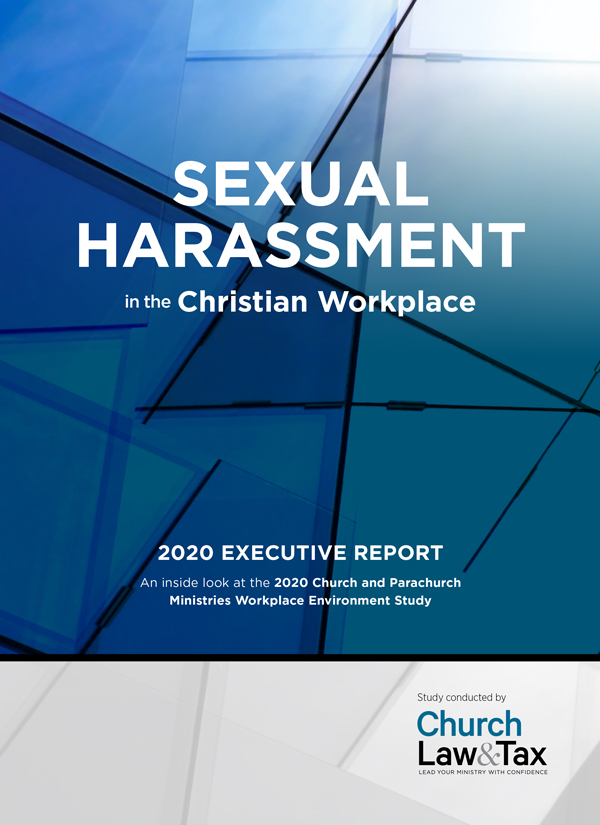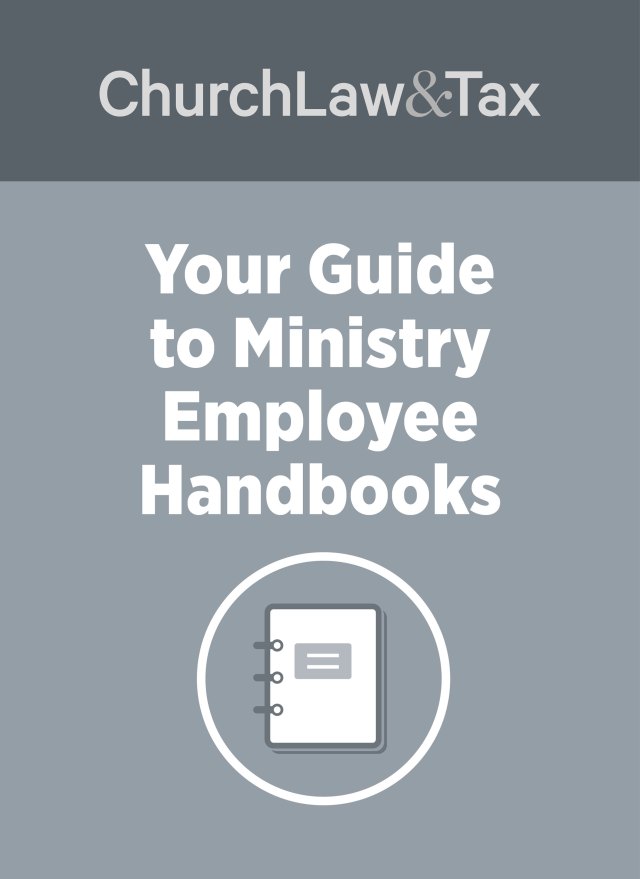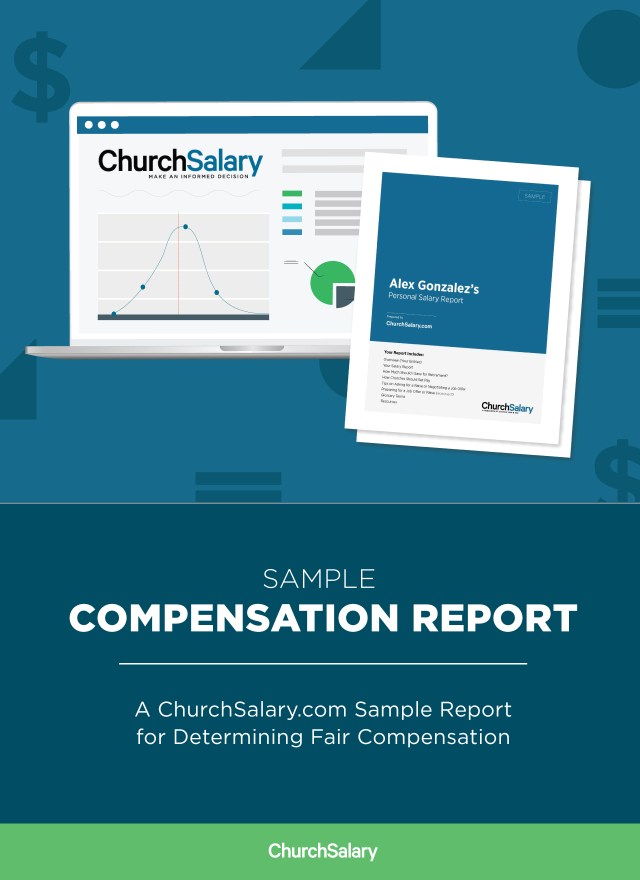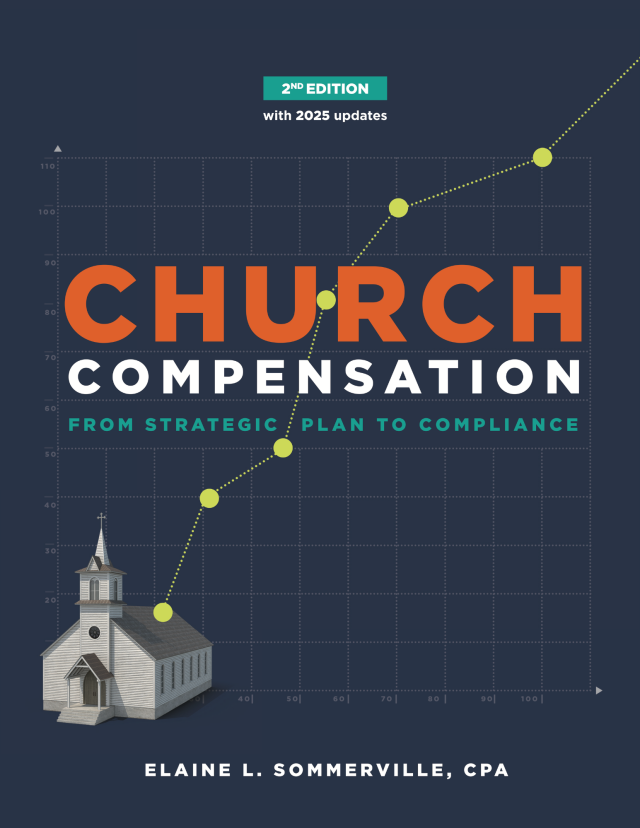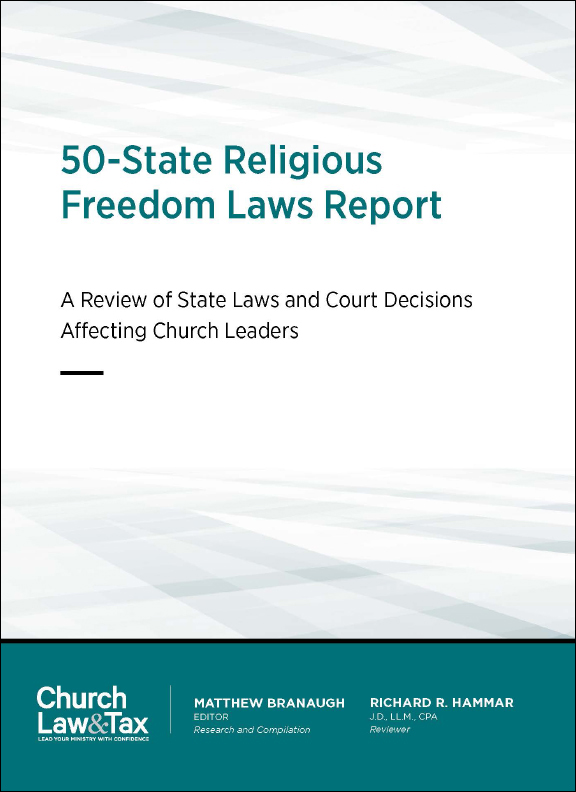The #MeToo and #ChurchToo movements have captured headlines and national attention in recent months, placing a renewed emphasis on understanding, exposing, and preventing sexual misconduct. It is imperative that churches and nonprofits understand the legal, practical, and public relations implications of this crucial subject. A poorly handled response to such an allegation will mangle the mission of the church or organization and may lead to an expensive and time-consuming legal labyrinth.
Legal claims for sexual harassment typically arise in the employment context. Therefore, it is of utmost importance that churches take action to prevent this threat from taking root in their workplaces and carefully address any issues that do arise in a prompt and honest way.
Key point. Under Title VII of the Civil Rights Act of 1964, sexual harassment is a form of sex-based discrimination. See 42 U.S.C. 2000e-2(a). Only churches with 15 or more employees that engage in interstate commerce are subject to Title VII. While only between 1 percent and 2 percent of all churches are subject to Title VII, several states enforce comparable laws—and many use a lower employee threshold.
Why churches need a policy
It may be tempting to believe that something as serious as workplace sexual harassment could never occur in your church. Understandably, many leaders may feel reluctant to think in detail about how to handle something so unpleasant and something that they hope will never happen. Still, the best time to create a sexual harassment policy is well before one is needed. It is much easier to create a wise plan of action before the pressures, emotions, and relational complexities among the people in your church arise in a moment of crisis.
A strong sexual harassment policy is crucial for three reasons:
- First, a good anti-sexual harassment policy may prevent sexual harassment in the first place. This policy will make clear to potential wrongdoers that this conduct has no place in your church. Because sexual harassment deals, in part, with what is or is not “welcome,” there is a great potential for misunderstanding between employees as to what kinds of comments, jokes, or actions are appropriate or inappropriate, and what constitutes illegal sexual harassment. Your policy should clarify what actions constitute sexual harassment and how your church will address those actions.
- Second, if the policy does not stop someone from engaging in harassing behavior, this policy will help your church address the serious issue for what it is, protect the rights of the victim and the accused, and move forward.
- Finally, implementing and following a strong sexual harassment policy may protect your church from civil liability, should it ever be sued regarding a sexual harassment allegation. For certain hostile work environment sexual harassment complaints, it is an affirmative defense to liability for an employer if it can prove it created a policy, communicated it to employees, and followed its complaint procedure. In certain other claims, the employer will not be held liable for sexual harassment that occurs if it shows that the employer took “immediate and appropriate action.”
Crafting an effective sexual harassment policy
A sexual harassment policy is vital to any church, organization, or business that has employees. There are many differences between the way for-profits and nonprofits should operate; however, both for-profits and nonprofits need a strong sexual harassment policy.
Further, a church or nonprofit may find certain behavior unacceptable, even if it is not illegal. For those situations, it may be helpful to create a high standard for your church and address indiscretions at that level, rather than awaiting misdeeds that are also a violation of law. In fact, the unique nature of churches and ministries allows them to enforce moral standards in accordance with their religious convictions to a greater extent than other organizations can. Of course, churches must enforce such moral standards consistently—for instance, not treating women less favorably than men. For additional insights on this topic of enforcing moral standards, see “Discrimination Based on Religion or Morals” in Pastor, Church & Law.
Thankfully, a sexual harassment policy need not be particularly long to be effective. It may only be a few pages by itself or it may be a part of the church’s broader employee handbook. However, there are seven central aspects that any policy should contemplate.
1. Make it broad in who it applies to and in what it prohibits
The policy should be clear that no harassment will be tolerated. Those who are found to have engaged in sexual harassment should be subject to discipline, up to and including termination.
Because there is a lot of uncertainty about what constitutes sexual harassment, define it for your employees so that there are no misunderstandings and no excuses. Federal government regulations define sexual harassment as:
Unwelcome sexual advances, requests for sexual favors, and other verbal or physical conduct of a sexual nature constitute sexual harassment when (1) submission to such conduct is made either explicitly or implicitly a term or condition of an individual’s employment, (2) submission to or rejection of such conduct by an individual is used as the basis for employment decisions affecting such individual, or (3) such conduct has the purpose or effect of unreasonably interfering with an individual’s work performance or creating an intimidating, hostile, or offensive working environment. 29 C.F.R. § 1604.11.
Your policy should be at least as broad, if not broader, than the federal government definition. You should also provide examples of what can constitute sexual harassment, such as:
- Unwanted physical contact or conduct of any kind, including sexual flirtations, touching, advances, requests for sex, or propositions;
- Repeated unwelcome requests for a romantic relationship;
- Verbal harassment of a sexual nature, such as lewd comments, sexual jokes or references, and offensive personal references;
- Demeaning, insulting, intimidating, or sexually suggestive comments about an individual;
- Graphic, verbal commentary about an individual’s body, sexual prowess, or sexual deficiencies;
- The display in the workplace of demeaning, insulting, intimidating, pornographic, or sexually suggestive objects, pictures, calendars, or photographs; and
- Demeaning, insulting, intimidating, or sexually suggestive written, recorded, or electronically transmitted messages (such as email, text messages, instant messaging, and internet materials, including social media and social networking sites).
Key point. Sexual harassment can occur between individuals of the opposite sex or of the same sex.
In sexual harassment cases, there is often confusion about how “consent” factors into the consideration. The standard is actually whether the actions or comments are “welcomed” by the individual and deemed as such by a reasonable person. Just because the victim does not immediately object does not mean that it is not “unwelcome.” Your policy should note this. Sometimes individuals do not lash out when they are offended by sexual misconduct. Some victims may immediately object or they may be surprised by what they perceive to be brazen misconduct and not know how to appropriately respond.
Tip. It is important to warn employees that violations of this policy can result in discipline, up to and including termination.
For more on defining sexual harassment, including specifics on “quid pro quo” and “hostile environment” harassment, examples demonstrating the need for a policy, and case studies, see this article by attorney and Church Law & Tax senior editor Richard Hammar.
2. Lay out a reporting procedure
The second important feature of a sexual harassment policy is creating a procedure to handle reports of sexual harassment. Employees who believe they may have been sexually harassed need to know who to go to and how to make a complaint.
You may want to encourage your employees who believe they are being harassed to firmly notify the offender that his or her behavior is unwelcome. There are some situations where that will put an end to the behavior. However, this will not always be possible, especially when the offender has a position of power or influence over the victim.
The reporting hierarchy will depend on the structure of your church. However, it is common to have employees notify their direct supervisor, manager, or human resources officer first and then senior executives if necessary. It is important to have multiple avenues of reporting in case the official who is supposed to receive reports is the one accused or ignores the report for any reason.
The policy should strongly encourage that sexual harassment complaints be in writing. This aids the investigation, if needed, and serves to preserve the memory of details that would otherwise become hazy with time. It also serves to confirm or dispel the possible response from the alleged offender that the complainant’s story has changed.
If the employee cannot give a written report, or prefers not to do so, the person receiving the report should document what was reported and when. If possible, have the employee review and verify the documented statement and agree to it with a signature.
3. Develop a framework for conducting an investigation
Your policy should include the framework of how you will conduct investigations. Importantly, once you receive a report, you have a duty to investigate it promptly. Promptness is important for a variety of reasons. It is much more difficult to determine what happened long after the fact. Also, the organization is often only protected from liability for harassment undertaken by one of its employees if it took immediate and appropriate action in response to a report.
The policy also should clearly state that your church will give a fair investigation, both to the one who reported the abuse and to the accused individual. Both the victim and the accused should be given the opportunity to present evidence to the investigator, tell his or her side of the story, and offer witnesses. You may want to indicate in your policy that employees will be required to participate with the investigation. There may be employees who are witnesses to the harassment but will not want to get involved in “office politics” unless you require them to talk to the investigator.
Some policies will reserve the right of employers to place any or all employees involved in the matter on administrative leave (with or without pay) while the investigation is pending. This is more commonly used for the accused employee. You may offer the alleged victim paid leave or reassignment during the investigation to protect his or her privacy. However, you should not force the alleged victim to go on leave or take reassignment, because that will appear to be retaliation against the employee for making a report.
Find guidance for choosing an investigator and the steps for conducting an investigation in this article.
4. Determine the standard of evaluation
The policy should also address what happens once the investigation concludes, and how certain the investigator must be before discipline is undertaken.
There are five standards used in the American legal system for evaluating whether a claim or charge brought in a matter prevails. These are listed below in increasing degree of rigor and certainty:
- Reasonable suspicion;
- Probable cause;
- Preponderance of the evidence (more likely than not)—used in most civil cases;
- Clear and convincing evidence;
- Beyond a reasonable doubt—used in most criminal cases.
Reasonable suspicion and probable cause are used as introductory matters in criminal cases to determine when certain investigations can be conducted and when searches, arrests, or charges may be made.
Preponderance of the evidence just means that there is more evidence in support of a claim than there is against it. Most civil cases are decided by that standard.
Clear and convincing evidence is a more stringent standard than preponderance of the evidence, but it is used less frequently.
Lastly, a criminal defendant cannot be convicted unless the evidence shows he is guilty beyond a reasonable doubt, the highest standard in American jurisprudence.
When there is a debate over what occurred, the standard of evaluation may make the crucial difference at the end of the investigation. A well-publicized example is the difference between the two O.J. Simpson cases. In those two cases, one civil and one criminal, the same facts, same witnesses, and same defendant led to different results because the evidence did not rise to the standard of beyond a reasonable doubt in the criminal case, but the evidence was enough to move past the preponderance of the evidence standard in the civil case.
A good policy will answer two questions:
- What standard is necessary to begin an investigation?
- What standard is required to find someone in violation and to exercise discipline?
At a minimum, there should be reasonable suspicion in order to begin an investigation. But you need more than that in order to take appropriate disciplinary action against someone. Most businesses, organizations, and churches will utilize the preponderance of the evidence standard, but some will opt for the more rigorous test of clear and convincing evidence. In any civil case against the church or organization for sexual misconduct, the standard or proof will be preponderance of the evidence. Thus, in most cases, it is appropriate and consistent to make preponderance of the evidence the standard for the investigation as well. However, some organizations choose to use the stricter clear and convincing standard. Clear and convincing evidence is a higher threshold reserved for allegations such as fraud in civil lawsuits (but less than beyond a reasonable doubt standard required for prosecution of criminal acts). Some churches believe that, under biblical standards, serious accusations against a spiritual leader (like an elder or a pastor) require a higher degree of certainty.
5. Provide confidentiality
Make it clear in your policy that complaints and investigations will be handled confidentially to the extent practical and appropriate under the circumstances. You should handle with sensitivity the report of the victim, interviews with the witnesses, and other information the investigation produces. You should also avoid jumping to false conclusions of such a serious nature as well, which can result in defamation lawsuits. However, you will still need to relay information to the accused and key stakeholders (e.g., board members, denominational leaders, or church members). What you communicate, when, and to which group of stakeholders is a good question to discuss with your legal counsel.
6. Prohibit retaliation for good faith reports
Your policy should prohibit any retaliation or retribution for reporting sexual harassment in good faith (meaning a report is made based on a genuine belief about the act in question, and not based on intentional dishonesty). Even if there is not enough evidence to support disciplining the accused, there should be no reprisals against the reporter if the report was made in good faith. You may want to address bad faith complaints. Fabricating allegations or lying during an interview may be its own cause for discipline or termination.
7. Consider off-premises conduct
You should also consider whether your policy will apply to conduct amongst employees that takes place during nonwork hours and outside of work. Our recommendation: Whether it is a work-sponsored activity or not, your policy should take a strong stance against any sexual harassment.
If a thorough investigation shows that one employee engaged in sexual harassment against another (or engages in other conduct which violates your church’s moral standards or code of conduct), the church may wish to impose discipline against that employee even though the actions occurred offsite and during nonwork hours. Just because the sexual harassment occurs between employees off-site or after-hours does not necessarily make it less damaging. It certainly does not make it less wrong. The actions of an employee can still dramatically impact the reputation of the employer.
If you want your church to be able to respond effectively in these types of situations, we advise that your policy and your employee handbook clearly explain that conduct (including sexual misconduct) at work and outside of work reflects on an employee’s ability to carry on the religious mission of the church and lead spiritually, and that such misconduct may warrant discipline from the church, up to and including termination.
Such a provision frequently appears in well-drafted employee handbooks. Such a provision could be included in documents that volunteers review and sign as well, but it is much less common to seek to govern off-site and after-hours conduct by an unpaid volunteer.
Follow-up: training and expectations
Once the policy is written, it is important for employees to understand it. They need training in how to handle sexual harassment allegations because helping them develop a clear understanding of expectations and procedures could prove pivotal in the event of a crisis, or better yet, it may avoid one altogether. One important component to this training will be the reporting process, including who employees should contact in the event an allegation arises. Retaining experts to conduct training on sexual harassment, either online or in person, will help develop this understanding while also building the culture of trust and transparency needed within a church workplace .
See also this article on conducting investigations in response to sexual harassment allegations.
This article is adapted primarily from “ Sexual Misconduct Part II: Policies and Investigations, ” with additional content from “ How Churches and Nonprofits Should Address Sexual Harassment in the #MeToo Era” —both by attorneys William R. Thetford Jr. and H. Robert Showers. Used with permission of Simms Showers, LLP. For additional content on this topic, along with samples of sexual harassment policies, go to SimmsShowersLaw.com.


